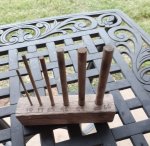I got my 18" WSM a bit over a year ago and have had some okay sessions. The one thing I'm still confused on is how to properly manage the heat using the vents at the bottom and top. There's a relationship between the bottom and top I'm just getting. So far I've gotten lucky but would like to understand them a bit more. I have a couple of questions:
1) What is the relationship between the bottom vents and the top vent? If I leave the bottom vents at about 1/2 way, can I simply manage the heat by the top vent only?
2) I assume less air (closed vents) means cooler temps. Yes? I know this is a pretty basic question, but I've gotten so many weird behaviors that I have to ask. Sometimes when I think I'm going to bring the temp down, it just keeps going up.
3) What is the heat's 'momentum'? In other words, if I have a target temp of 225 and the vents are pretty open to bring it to temp, when should I start closing them so I don't overshoot it by too much? (assuming closing them brings down the temp)
Thanks in advance. I know these are pretty basic, but as I said earlier, it's been hit/miss with my sessions and I would like to understand the vents a bit more if possible.
1) What is the relationship between the bottom vents and the top vent? If I leave the bottom vents at about 1/2 way, can I simply manage the heat by the top vent only?
2) I assume less air (closed vents) means cooler temps. Yes? I know this is a pretty basic question, but I've gotten so many weird behaviors that I have to ask. Sometimes when I think I'm going to bring the temp down, it just keeps going up.
3) What is the heat's 'momentum'? In other words, if I have a target temp of 225 and the vents are pretty open to bring it to temp, when should I start closing them so I don't overshoot it by too much? (assuming closing them brings down the temp)
Thanks in advance. I know these are pretty basic, but as I said earlier, it's been hit/miss with my sessions and I would like to understand the vents a bit more if possible.

